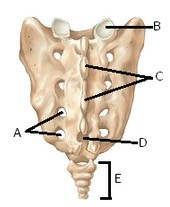Which of the following is common in the distal small intestine?
A. MALT
B. Macrophages
C. Diffuse lymphatic tissue
D. Lymphatic nodules
E. Aggregated lymphoid nodule
Answer: E. Aggregated lymphoid nodule
You might also like to view...
The first set of teeth to appear are the ________ teeth.
A) permanent B) succession C) secondary D) impacted E) deciduous
 The figure illustrates the sacrum. What structure does "B" represent?
The figure illustrates the sacrum. What structure does "B" represent?
A. Median sacral crest B. Posterior sacral foramina C. Superior articular facet D. Sacral hiatus E. Coccyx
Identify the three ways that carbon dioxide is transported in the bloodstream
A) Bound to hemoglobin, bound to other transport proteins, or bound to the surface of the RBCs. B) Dissolved in plasma, bound to the surface of the RBCs, or as bicarbonate ions in the plasma. C) Dissolved in plasma, as hydrogen ions in the plasma, or bound to hemoglobin. D) Bound to hemoglobin, bound to the surface of the RBCs, or as hydrogen ions in the plasma. E) Dissolved in plasma, bound to hemoglobin, or as bicarbonate ions in the plasma.
Which of the following correctly pairs the lymphatic trunk with the lymphatic duct that drains into it?
A) right bronchomediastinal trunk, thoracic duct B) left bronchomediastinal trunk, right lymphatic duct C) intestinal trunk, right lymphatic duct D) right jugular trunk, thoracic duct